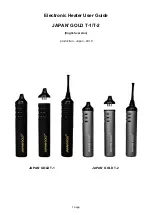
30
•
When connecting the indoor unit to the connection pipe, do not force the cou-
plings on the indoor unit, as this could cause cracks in the capillary pipes and other
pipes on the indoor unit, causing them to leak.
•
The connection pipe must be supported by a suitable bracket. The unit should not
bear the weight of the pipe.
•
To avoid leaks and the formation of condensate on the connection pipes, these
must be covered in thermal insulation material bound with adhesive tape and in-
sulated from the air.
•
The connection joint with the indoor unit must be wrapped in thermal insulation.
There must be no gaps between the pipe connection and the wall of the indoor
unit.
•
After wrapping the pipes in protective material, they should never be bent at an
acute angle as this could crack or break them.
•
Use adhesive tape to cover the pipes:
−
Use adhesive tape to bind together the connection pipes and the cables. To pre-
vent condensate flowing out of the discharge pipe, separate the discharge pipe
from the connection pipe and cables.
−
Use thermal insulating tape to bind together the pipes from the bottom of the
outdoor unit to the upper end of the pipe where it enters the wall. When using
insulating tape, the final wrap should half cover the first wrap of tape.
Gas pipe
External sheath
Condensate discharge pipe
Insulating
Liquid pipe
SERIAL CONNECTION:
Insulating
Indoor unit
Refrigerant connection diameters
GAS
mm (inch)
LIQUID
mm (inch)
TRS1001DX
15,9(5/8”)
(1)
9,52(3/8”)
(2)
No gap
•
To facilitate condensate discharge, install the condensate tube with a tilt of
1/50~1/100. Its couplings must be coated with heat insulation materials to prevent
the formation of condensate on the outside.
•
When connecting the condensate discharge tube, do not apply excessive force on
the side coupling of the unit. The tube fixing position must be near the unit.
•
Use a rigid PVC tube of the common type as a condensate discharge hose. When
making the connection, couple the end of the PVC tube in the condensate dis-
charge hole. Use a flexible condensate discharge tube, fixing it in place with a
clamp. Never use adhesives to connect the condensate discharge hole and the
flexible condensate discharge hose.
•
When the condensate discharge hose is used for several units, the common tube
must be about 100mm lower than the condensate discharge outlet of each unit. In
this case, use a thicker tube.
(1) GAS LINE
The diameter of the refrigerant connection is 1/2” (12.7mm), the scope of delivery
includes an adapter to change from 1/2” (12.7mm) to 5/8” (15.9mm) complete with
pipe coupling for 5/8” (15.9) pipe and ½” truncated conical gasket made of copper.
(2) LIQUID LINE
The diameter of the refrigerant connection is 1/4” (6.35mm), the scope of delivery
includes an adapter to change from 1/4” (6.35mm) to 3/8” (9.52mm) complete with
pipe coupling for 3/8” (9.52) pipe and ¼” truncated conical gasket made of copper.
CONDENSATE DISCHARGE
HYDRAULIC CONNECTIONS
WARNING: make sure the condensate water drains off correctly. The connec-
tion of the condensate discharge hose must be leak-free
Содержание TRS 1001DX
Страница 17: ...17 SCHEMA ELETTRICO ...
Страница 18: ...18 ...
Страница 34: ...34 WIRING DIAGRAM ...
Страница 50: ...50 SCHÉMA ÉLECTRIQUE ...
Страница 66: ...66 ELEKTRISCHES SCHEMA ...
Страница 82: ...82 ESQUEMAS ELÉCTRICO ...
Страница 83: ...83 ...
















































